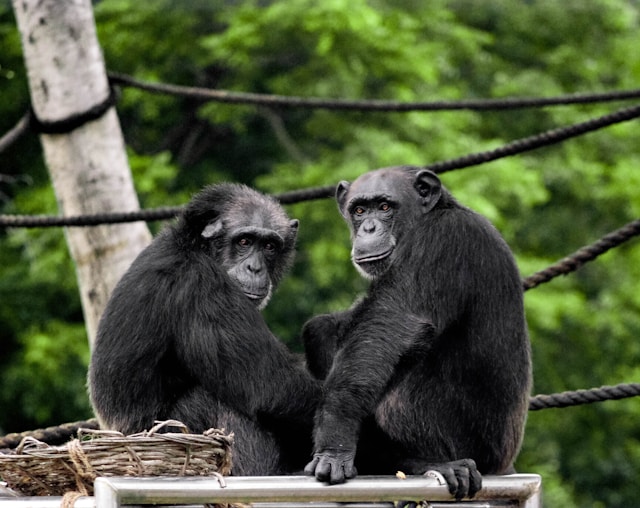New research reveals that wild chimpanzees use fast-paced turn-taking and interruptions in their gestures, mirroring human conversational dynamics
Wild chimpanzees have been observed engaging in conversations that bear striking similarities to human dialogue, according to recent research published in Current Biology. The study, conducted by scientists from the University of St Andrews, reveals that these primates use a form of snappy, turn-taking communication, characterized by quick exchanges and occasional interruptions.
Chimpanzees communicate predominantly through gestures, including hand movements and facial expressions. This non-verbal form of interaction allows them to convey complex messages and coordinate social activities. Professor Cat Hobaiter, who led the study, explained that the chimpanzees’ conversational patterns closely resemble those of human conversations. “We all take around 200 milliseconds between turns in a conversation,” Hobaiter told BBC News. “Chimpanzees also display a similar rapid turn-taking, with some variation depending on their social context.”
Embed from Getty ImagesThe researchers spent years observing and recording the interactions of chimpanzee communities in the forests of Uganda and Tanzania. They analyzed over 8,000 gestures from more than 250 individual chimpanzees to understand their communication patterns. This detailed observation revealed that while chimpanzees generally took turns in their gestures, the timing of these exchanges varied widely. Some chimpanzees interrupted their partners shortly before they finished their gestures, while others took significantly longer to respond.
Hobaiter highlighted that these timing differences could be attributed to the natural setting in which the observations took place. Unlike controlled environments, wild settings allow for a broader range of behaviors, including interruptions and extended pauses. Despite this variability, the overall timing of chimpanzee conversations was remarkably similar to human interactions.
Dr. Gal Badihi, another researcher involved in the study, noted that chimpanzee gestures often serve practical purposes, such as coordinating group activities or avoiding conflicts. For example, a chimpanzee might use a gesture to request food or to signal that it wishes to be left alone. These gestures facilitate social interactions and help manage group dynamics, demonstrating the complexity and efficiency of their communication system.
The study’s findings offer valuable insights into the evolutionary origins of human conversation. By comparing chimpanzee communication with human dialogue, scientists hope to unravel the development of conversational rules and social interactions in primates. Future research will likely focus on other primate species to further understand the evolution of communication and its underlying mechanisms.
Analysis:
Political:
The findings from this research have implications for our understanding of primate conservation policies. Recognizing the sophisticated nature of chimpanzee communication underscores the need for preserving their natural habitats. Effective conservation strategies must consider the social and communicative needs of these animals, advocating for environments where they can maintain their complex social interactions.
Social:
This study highlights the deep-rooted similarities between human and chimpanzee communication, challenging our perceptions of animal behaviour. It underscores the importance of understanding and respecting the cognitive and social abilities of non-human primates. The revelation that chimpanzees use fast-paced, turn-taking gestures in their interactions can foster greater empathy and support for primate conservation efforts.
Racial:
While the study does not directly address racial issues, it contributes to a broader discussion about the shared characteristics between humans and other primates. By examining these similarities, scientists and the public alike can gain a greater appreciation for the evolutionary connections between species, promoting a more inclusive understanding of our place in the animal kingdom.
Gender:
The research does not specifically address gender differences in chimpanzee communication. However, understanding how both male and female chimpanzees participate in these conversational exchanges could offer insights into gender roles within primate societies. Future studies might explore whether and how gender influences communication patterns in chimpanzees, mirroring similar inquiries in human sociolinguistics.
Economic:
The study’s implications extend to the economic aspects of primate research and conservation. By highlighting the sophisticated nature of chimpanzee communication, the research may boost funding and support for conservation programs. Enhanced understanding of primate behaviour can lead to more effective educational programs and ecotourism opportunities, contributing to local economies and global conservation efforts.
